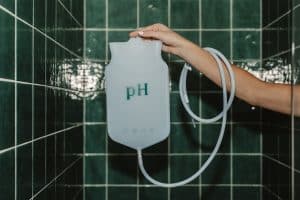In the past 10 years, “Gut Health” awareness has really taken off in mainstream society. We hear a lot about probiotics and the importance of them to ensure our microbiome is diverse and flourishing. We don’t however hear as much about the importance of prebiotics such as PHGG and the long term and lasting effect that they establish.
What is PHGG
PHGG (Partially Hydrolyzed Guar Gum) is a prebiotic fibre. Guar Gum come from Guar Beans which are harvested predominantly in India. Guar gum may be familiar to you as it is often used as a thickener or stabliser in sauces and other processed foods. The main prebiotic starch found in guar gum is Glucomannan. The bacteria in your colon ferments Glucomannan into intestinal fuel called short chain fatty acids (SCFAs) like butyrate, propionate, and acetate. These SCFAs provide wide-reaching benefits for gut and immune health.
As I mentioned, Guar gum is a thickener therefore it is viscous and will swell with water and create gels and thicken solutions. This can be too much for those with constipation or risk of intestinal blockages. Good news, due to the processing that Guar Gum goes under to create PHGG, PHGG does not have the viscous or swelling properties of guar gum, therefore should be easily assimilated for people with digestive issues.
Are you scared of Fibre? Many of us are. Have you been told from your GP or Gastroenterologist “ensure you are getting enough Fibre in your diet to maintain bowel health”?
Then when you do, have you found yourself more constipated, bloated and gassy than ever before? This could be because you are feeding an imbalanced ecosystem with the wrong types of fibre. We’ve all heard the phrase “an apple a day keeps the doctor away” but have you thought about what exactly is in these fruits that keeps you out of the waiting room?
Not all Fibre is made the same
The latest health trends are pointing to fibre as the key to disease-free living. We need to understand a bit more about Fibre before we decide if this is the case.
Apples, like many fruits and vegetables, are made of fibre – the skin is made of tough insoluble fibre and the fruit contains pulpy soluble fibre.
When eaten, these two fibres affect the body differently. Insoluble fibre remains relatively unchanged throughout the gut, bulking up stool and speeding up the passage of food and waste.
Soluble fibre, on the other hand, is more complex. Soluble fibres become a gel-like paste in your stomach, this paste is very good at absorbing sugar, fat and cholesterol from other foods so that you don’t absorb them into your blood. This is the reason why the 22 g of sugar in an apple is not absorbed as quickly as sugars in soft drink.
Further down in the gut, good bacteria will ferment soluble fibres to produce short-chain fatty acids. We are only beginning to understand the importance of short-chain fatty acids. What we know so far points to their role as the main source of energy for cells in the colon and have protective effects against obesity and colon cancer.
The same thick viscous gel that gives soluble fibre its health benefits is also the bane of anyone suffering from a gastrointestinal motility disorder. As you can imagine, having a lump of highly viscous gel in your stomach or intestinal tract can literally grind things to a halt. This is where PHGG comes in. Recently, the potential of low viscosity soluble fibres have come into the spotlight. Promising to be easier to digest but also retaining all the benefits.
Not all Fibre is made the same
The latest health trends are pointing to fibre as the key to disease-free living. We need to understand a bit more about Fibre before we decide if this is the case.
Apples, like many fruits and vegetables, are made of fibre – the skin is made of tough insoluble fibre and the fruit contains pulpy soluble fibre.
When eaten, these two fibres affect the body differently. Insoluble fibre remains relatively unchanged throughout the gut, bulking up stool and speeding up the passage of food and waste.
Soluble fibre, on the other hand, is more complex. Soluble fibres become a gel-like paste in your stomach, this paste is very good at absorbing sugar, fat and cholesterol from other foods so that you don’t absorb them into your blood. This is the reason why the 22 g of sugar in an apple is not absorbed as quickly as sugars in soft drink.
Further down in the gut, good bacteria will ferment soluble fibres to produce short-chain fatty acids. We are only beginning to understand the importance of short-chain fatty acids. What we know so far points to their role as the main source of energy for cells in the colon and have protective effects against obesity and colon cancer.
The same thick viscous gel that gives soluble fibre its health benefits is also the bane of anyone suffering from a gastrointestinal motility disorder. As you can imagine, having a lump of highly viscous gel in your stomach or intestinal tract can literally grind things to a halt. This is where PHGG comes in. Recently, the potential of low viscosity soluble fibres have come into the spotlight. Promising to be easier to digest but also retaining all the benefits.
What makes Soluble fibre viscous?
Soluble fibres are made up of simple sugars joined up to form a long chain called polysaccharide. The longer the polysaccharide chain the more tangled they become when mixed together and the more viscous the fibre. Psyllium husk, primary ingredient in Metamucil, forms a thicker gel than oat bran because it’s made up to create longer polysaccharide chains.
The simplest way to reduce viscosity is to have shorter polysaccharide chains. Partially hydrolysed guar gum (PHGG) is the most well-known, it is created by artificially cutting guar gum into shorter chains.
Benefits of PHGG
- PHGG improve symptoms for both constipation-dominant and diarrhoea-dominant IBS. While benefits can be found for other prebiotic fibres too, patients routinely report a preference for PHGG over other prebiotic sources. (2; 3; 4; 5; 6)
- PHGG may also help constipation as it mildly boosts bowel frequency, fecal moisture, and the presence of Lactobacilli species (7).
- Supplementation improves IBS symptom frequency, while the same benefit is not always apparent for other fibre supplements (8)
- PHGG improved laxative dependence in a nursing home population and may help with diarrhoea associated with tube-feeding (9), and septic patients (10; 11).
- PHGG is also popular in SIBO treatment. A 2010 clinical trial demonstrated that when PHGG was recommended alongside rifaximin (a pharmaceutical antibiotic), SIBO eradication outcomes were even better than just rifaximin alone (12).
Remember to start slow and work your way up with ANY prebiotic protocol. Unique circumstances can change the type and amount of probiotics/prebiotics you take so check with your practitioner on what is right for you.
It can be useful to directly help rid overgrowth of pathogens/bad bacteria via natural antibiotic compounds and, occasionally, pharmaceuticals at least in the beginning of a gut program.
Probiotics and prebiotics like PHGG can be essential adjuncts to remove bad bugs, replace good ones, and sustain the changes long-term.
Book in with one of our incredible Colonic Hydrotherapists today and get your Gut back on track with some treatments and supplemental intervention specific to your needs.
Often IBS, Bloating and Constipation can be a result of an overburdened digestive system that needs a reset. Colonics are a great way to allow the body to get rid of its toxic load and make new healthy foundations internally.


